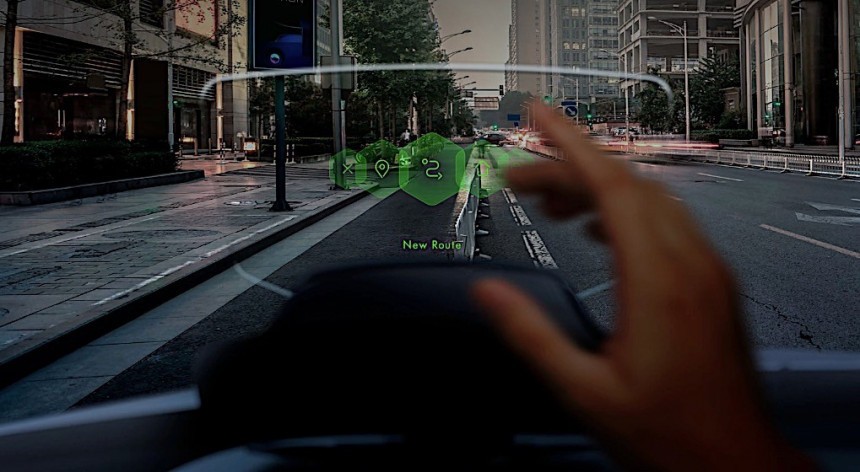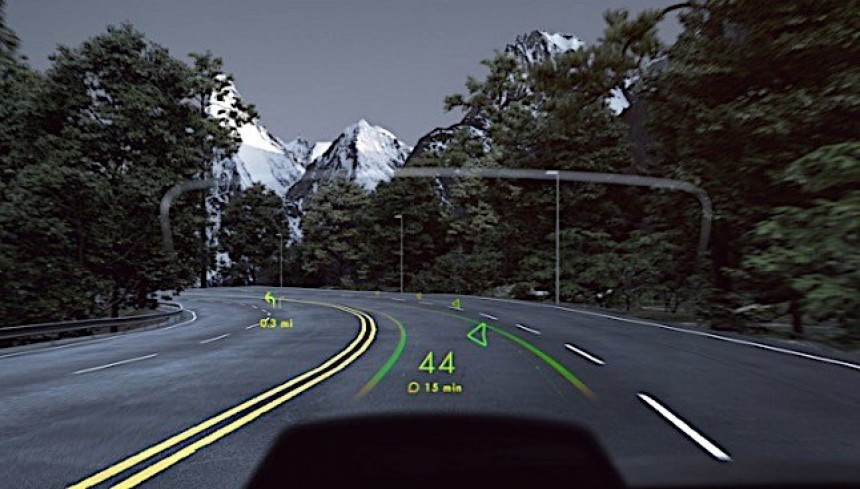On September 19, Porsche announced it has become a major investor in Swiss start-up WayRay. The company is involved in developing holographic augmented reality displays for automobiles, to be used in lieu of existing displays that tend to take the driver’s eyes off the road for shorter or longer periods of time.
The idea of head-up displays (HUD) is not new for the automotive sector and is currently being used to some degree or another by several high-end car manufacturers. WayRay’s idea, however, takes HUD to a whole new level by incorporating in it augmented reality.
Currently, carmakers use one of two types HUDs for their cars: they either include it in the windshield itself, by using a projector whose information is reflected back to the driver, or use a tool that has a screen separate from the windshield.
For now, WayRay’s aftermarket solution, called Navion, takes the second approach, meaning it can be used virtually by anyone who owns a vehicle as an aftermarket piece of equipment. The solution deployed in Navion, however, could just as well be used for embedded holographic displays.
WayRay calls the Navion solution the world’s first holographic navigation system for cars. It comprises a holographic optical element, a photopolymer film that “retains the properties of a periodic nanostructure after the recording process.” and a built-in full HD camera that is used to scan the surrounding of the car.
The technology gathers together the available information and puts it together as an augmented reality image that can be seen by the drivers without the need of any special equipment like glasses.
The device created by WayRay can be placed on the dashboard and shows a variety of information, from trip details and directions to real-time indicators highlighting pedestrians, points-of-interest or hazards.
Navion can be controlled either via voice commands or through hand gestures, without the need to actually touch the screen. Via hand gestures, users can browse the menu, choose routes, or points-of-interest.
HOW IT WORKS
What Navion essentially does is take the maps currently used by GPS apps and overlays them on the real world environment.
Through hardware-accelerated video feed processing and AR rendering, the data collected by the system is transformed into a virtual image that can cover a distance of up to 30 feet (9 meters) in front of the car, meaning anything within that distance can be identified and displayed on the screen of the Navion.
That makes all the information relayed to the driver seem like part of the environment so any indications like those pertaining to direction change or time to the destination can be processed by the human behind the wheel while his eyes are still on the road.
For navigation, the main idea behind building the Navion, WayRay will provide the system with two options. The AR navigation mode will provide the driver with route directions that adjust continuously as the car moves and the surroundings change. All other info available is included in the AR environment.
The turn-by-turn navigation mode, however, limits the amount of information displayed to the basic navigation icon.
The WayRay Navion is still in development. It was shown for the first time in January, at the CES 2018. The tech used for it has been under testing for several years, including in the windshield-mounted mode.
Now that Porsche got involved, it likely major leaps will be made in the year ahead.
Currently, carmakers use one of two types HUDs for their cars: they either include it in the windshield itself, by using a projector whose information is reflected back to the driver, or use a tool that has a screen separate from the windshield.
For now, WayRay’s aftermarket solution, called Navion, takes the second approach, meaning it can be used virtually by anyone who owns a vehicle as an aftermarket piece of equipment. The solution deployed in Navion, however, could just as well be used for embedded holographic displays.
WHAT IS IT
The technology gathers together the available information and puts it together as an augmented reality image that can be seen by the drivers without the need of any special equipment like glasses.
The device created by WayRay can be placed on the dashboard and shows a variety of information, from trip details and directions to real-time indicators highlighting pedestrians, points-of-interest or hazards.
Navion can be controlled either via voice commands or through hand gestures, without the need to actually touch the screen. Via hand gestures, users can browse the menu, choose routes, or points-of-interest.
HOW IT WORKS
The device gathers the information it needs by using inertial sensors, GPS sensors, and the full HD camera. These tools are used to continuously map the environment while keeping track of the car’s whereabouts in relation to the surroundings through a process called simultaneous localization and mapping (SLAM).
Through hardware-accelerated video feed processing and AR rendering, the data collected by the system is transformed into a virtual image that can cover a distance of up to 30 feet (9 meters) in front of the car, meaning anything within that distance can be identified and displayed on the screen of the Navion.
That makes all the information relayed to the driver seem like part of the environment so any indications like those pertaining to direction change or time to the destination can be processed by the human behind the wheel while his eyes are still on the road.
For navigation, the main idea behind building the Navion, WayRay will provide the system with two options. The AR navigation mode will provide the driver with route directions that adjust continuously as the car moves and the surroundings change. All other info available is included in the AR environment.
The turn-by-turn navigation mode, however, limits the amount of information displayed to the basic navigation icon.
PROSPECTS
Now that Porsche got involved, it likely major leaps will be made in the year ahead.















